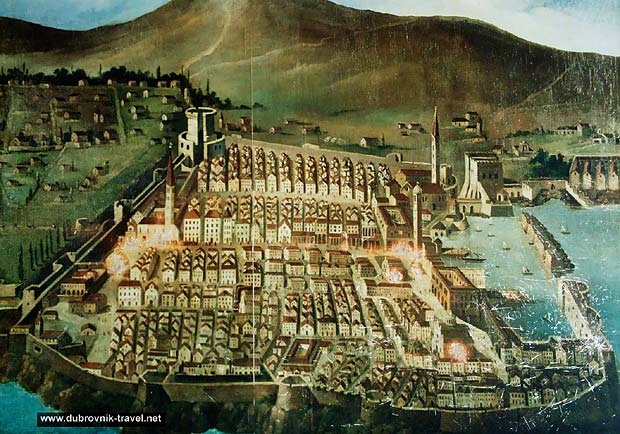History of Dubrovnik 3 – The beginning of trade

Above photo: Old Painting of Dubrovnik
It was in the 12th century that Dubrovnik developed the crucial foundations of its future development, maritime trade and commerce. It was Dubrovnik’s ability to make full use of its perched borderland position that would secure its uniqueness and reputation as a link between east and West. This meant taking over control of the trade between the west and the Slavic states on the Balkan peninsular. This process started in the 11th century and would last until the last days of the Republic in 1808.
The first known commercial contract goes back to 1148 and was signed with the city of Molfetta across the Adriatic in the Appugilia region of Italy. This was followed by deals with other city states and empires in the following decades, including Pisa in 1169, Ravenna and Rovinj in 1188, Fano and Ancona in 1190 as well as Termoli and Naples.
In 1191, the city’s merchants were granted the right to trade freely in Byzantium by Emperor Isaac II Angelos. Similar privileges were obtained several years earlier from the Serbian ruler Nemanja (1186), who promised the Dubrovnik traders security as well as the right to trade freely. A similar deal was reached with Bosnia in 1189. The treaty with Bosnian Ban Kulin is also the first official document where the city is referred to as Dubrovnik.
Trade in feudal dominated, early medieval times was challenging. It was frequently dangerous, with the trader needing his soldiering skills as much as his trading skills. Dubrovnik’s traders were able to reach all the parts of the Balkans, an audacity which was to cost many their lives. In his account of the ‘Mediterranean’, the French historian Braudel recounts how a Dubrovnik merchant captured and ransomed by Algerian pirates made such a fuss that he was thrown overboard.
By the end of the 12th century Dubrovnik had become an important trading centre on the coast, providing an important link between the Mediterranean and Balkan states. From the hinterlands, cattle and dairy products, wax, honey, timber, coal, silver, lead, copper and slaves were exported along with Dubrovnik products such as salt, cloth, wine, oil and fish.
As the city grew increasingly prosperous it posed a threat to the other major commercial power in the Adriatic – Venice. The most Serene Republic used crusaders from the 4th crusade to capture the cities of Zadar in 1202 and Constantinople in 1204 in order to weaken the Byzantine Empire’s hold on the Adriatic and thus the Mediterranean. The following year, in 1205, Dubrovnik itself came under Venetian authority in 1205 and remained under its control for 150 years. Venice was now in the position to anoint the knez (ruler) and would also send the archbishop of its own choice.
It was under Venetian rule of some 150 years that Dubrovnik developed some important institutions, influenced on the Venetian model. The Venetian rule lasted for a century and a half, determining the institutional structure of the future republic, with the emergence of the Senate (1252) and the approval of the Ragusa Statute (May 9, 1272). Despite accepting governance from Venice, the city maintained its municipal autonomy and also continued to establish its own independent commercial relations. (Vicko Marelic)
Need Entry Tickets to Town Walls? Buy Now
Dubrovnik History Articles
- The History of Dubrovnik – an introduction
- The foundation in the Dark Ages – balancing on a borderland
- Early medieval times
- The beginning of trade
- Trade Agreements with Balkan Countries
- Breaking Away From Venice and Territorial Expansion
- The Ottomans Arrive
- Dubrovnik’s Golden Age
- Dubrovnik as the Focal Point of Dalmatian Enlightment
- Rudjer Boskovic – Dubrovnik’s Shining Example of the Enlightement
- The Jews of Dubrovnik

 Subscribe
Subscribe